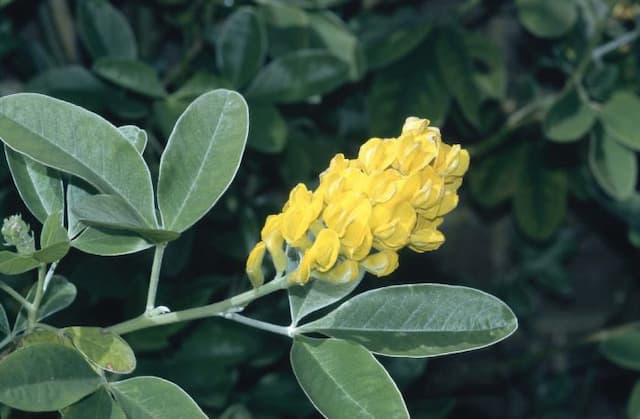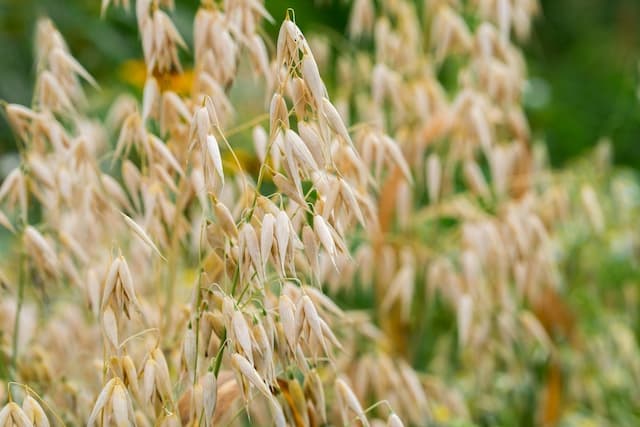Sweet pea Lathyrus odoratus 'Busby'

ABOUT
The Lathyrus odoratus 'Busby', commonly known as the sweet pea 'Busby', is a captivating flowering plant that adds a splash of color and fragrance to any garden. This particular variety usually boasts blossoms that exhibit a range of soft colors, often in pastel shades. The flowers are characterized by their delicate and ruffled appearance, which adds a touch of romantic, old-fashioned charm. Each bloom is made up of several petals arranged around a central core, with some varieties featuring intricate patterns or a bi-color scheme, where the edges contrast against the main color of the petal. The sweet pea 'Busby' also has a notable fragrance that is sweet and rich, often described as reminiscent of honey and orange blossoms, which can be noticed especially on warm days, attracting bees and butterflies to the garden. The foliage of the sweet pea 'Busby' consists of slim, green leaves that are elongated with a slightly vining tendency, hinting at the plant's climbing habit. Thin tendrils emerge from the plant, seeking out support to cling to, allowing the sweet pea to gracefully ascend structures such as trellises, fences, or arches, making it a great choice for vertical interest in a garden setting. Overall, the aesthetic of the sweet pea 'Busby' is defined by its lovely blooms, delightful scent, and slender, climbing greenery, which lend themselves to creating a picturesque cottage garden tableau or an elegant floral display when cut for indoor arrangements.
About this plant
 Names
NamesFamily
Fabaceae.
Synonyms
Sweet Pea, Everlasting Pea, Perennial Pea, Lathyrus.
Common names
Lathyrus odoratus.
 Toxicity
ToxicityTo humans
The Lathyrus odoratus, commonly known as sweet pea, is generally not considered highly toxic to humans. However, it does contain aminopropionitrile, which can cause a condition known as lathyrism if ingested in large quantities over a long period. Lathyrism results from the disruption of collagen synthesis in the body and can lead to symptoms such as paralysis, labored breathing, and convulsions. It's important to note that these toxic effects are typically associated with the seeds and, less commonly, with other parts of the plant. Accidental ingestion of small amounts occasionally by children or adults usually does not result in poisoning.
To pets
Sweet pea is also toxic to pets, including dogs, cats, and horses. The seeds are the most toxic part and contain a compound that can cause a neuromuscular condition known as "lathyrism" if ingested in large quantities. Symptoms of sweet pea poisoning in pets can include lethargy, weakness, pacing, head pressing, tremors, seizures, and difficulty breathing. Chronic ingestion can also lead to skeletal malformations and breakdown. If you suspect your pet has ingested sweet pea seeds, it's important to seek veterinary care promptly.
 Characteristics
CharacteristicsLife cycle
Annuals
Foliage type
Deciduous
Color of leaves
Green
Flower color
Mixed
Height
5 feet (1.52 meters)
Spread
1 foot (0.3 meters)
Plant type
Climber
Hardiness zones
Varies
Native area
Mediterranean
Benefits
 General Benefits
General Benefits- Aesthetic Appeal: Lathyrus odoratus 'Busby', commonly known as sweet pea, has vibrant and colorful flowers that enhance the visual appeal of gardens and landscapes.
- Fragrance: Sweet pea is known for its sweet fragrance, which can add a pleasant aroma to outdoor spaces and cut flower arrangements.
- Climbing Growth Habit: With its climbing nature, sweet pea can cover trellises, fences, and pergolas, providing vertical interest in garden designs.
- Attracts Pollinators: Sweet pea flowers attract bees, butterflies, and other beneficial pollinators to the garden, supporting biodiversity.
- Easy Cultivation: Sweet pea is generally easy to grow from seed, making it a good choice for beginner gardeners or those looking for low-maintenance plants.
- Seasonal Color: Flowering mainly in the spring and early summer, sweet pea provides seasonal color and can be used in temporal garden designs.
- Edible Pea Pods: While not all varieties are edible, some sweet peas produce pods that can be harvested and consumed when the plants are grown properly and without toxic treatments.
- Historical Significance: Sweet pea has been a popular plant for centuries, with a rich history in horticulture, providing a sense of tradition and heritage in gardens.
- Versatility: Sweet pea can be grown in a variety of settings including borders, containers, and as cut flowers, making it a versatile choice for different gardening applications.
 Medical Properties
Medical PropertiesThis plant is not used for medical purposes.
 Air-purifying Qualities
Air-purifying QualitiesThis plant is not specifically known for air purifying qualities.
 Other Uses
Other Uses- As an addition to compost heaps: Sweet pea plants can be added to compost piles once they have finished flowering, as they provide green waste that helps to create a nutrient-rich compost.
- Natural pest repellent: The scent of sweet peas can deter certain pests, making them useful to plant alongside vegetables and fruit crops as a form of companion planting.
- Floral crafts: Dried sweet pea flowers can be used in potpourri or in other dried floral arrangements to maintain a pleasant fragrance within the home.
- Teaching plant biology: Sweet peas are often used in school projects and studies to teach children about pollination, plant growth cycles, and genetics due to their distinct hereditary traits.
- Photography and art: Due to their vibrant colors and appealing form, sweet peas are often used as subjects in photography and botanical illustration.
- Traditional dye: In historical contexts, the petals of sweet peas may have been used to create natural dyes for textiles, although this is less common today.
- Culinary garnish: Although they are not edible, sweet pea flowers can be used as temporary garnishes for culinary dishes, provided they are removed before consumption.
- Event decorations: Sweet pea flowers can be used in natural confetti, or in decorative garlands and wreaths for events like weddings and garden parties.
- Fragrance extraction: While not commonly practiced, the fragrant compounds from sweet peas can be extracted to make natural perfumes or scented oils.
- Garden structure: Growing sweet peas up trellises or arbors can provide aesthetic garden structure and support for these climbing plants.
Interesting Facts
 Feng Shui
Feng ShuiThe Sweet Pea is not used in Feng Shui practice.
 Zodiac Sign Compitability
Zodiac Sign CompitabilityThe Sweet Pea is not used in astrology practice.
 Plant Symbolism
Plant Symbolism- Pleasure: Sweet pea flowers, including the Lathyrus odoratus 'Busby' variety, have been associated with delicate pleasure due to their sweet fragrance and gentle appearance.
- Goodbye: Sweet peas have historically been used to signify a farewell or departure, possibly because they represent a sweet memory as one leaves.
- Thankfulness: The sweet pea is often given to express thanks, perhaps for a lovely time or for the joy that the company of the recipient has brought.
- Blissful pleasure: An extension of the primary symbolism of pleasure, this suggests a deeper, more resonant joy or contentment.
- Lasting pleasure: Sweet peas symbolize the idea of enjoying the moment and making memories that will be treasured over time.
 Water
WaterSweet peas require regular watering to keep their soil consistently moist but not waterlogged. Water them with about 1 inch of water per week, which is roughly 0.625 gallons for a typical garden. However, this amount can vary based on temperature and soil conditions. During hot or windy weather, they might need water more frequently. Always check the top inch of the soil before watering; if it feels dry, it’s time to water. A deep watering once a week is preferable to frequent, shallow watering as it encourages deeper root growth.
 Light
LightSweet peas thrive in full sunlight but appreciate some afternoon shade in hotter climates. They should receive a minimum of six hours of sunlight per day. A spot that gets morning sunlight is ideal because it warms the plant without exposing it to the intense heat of the afternoon sun.
 Temperature
TemperatureSweet peas prefer cooler temperatures and can endure short periods of frost. They grow best when daytime temperatures are between 55 and 65 degrees Fahrenheit, with night temperatures ideally around 50 degrees Fahrenheit. They can survive in temperatures as low as 25 degrees Fahrenheit but will not tolerate prolonged exposure to temperatures over 75 degrees Fahrenheit.
 Pruning
PruningPrune sweet peas to encourage bushier growth and more blooms. Pinch out the growing tip after the plant has produced a couple of pairs of leaves. Throughout the season, remove spent flowers and seed pods regularly to promote continued blooming. The best time for major pruning is in late winter or early spring before the new growth begins.
 Cleaning
CleaningAs needed
 Soil
SoilSweet peas prefer rich, well-draining soil with a pH between 6.0 and 7.5. The best mix would be a combination of garden soil, compost, and perlite or vermiculite for improved drainage. It's beneficial to work in some well-rotted manure or compost to provide nutrients.
 Repotting
RepottingSweet peas are typically grown as annuals, so repotting is often not necessary. If grown in containers, they may need to be repotted every spring when starting new plants or if they outgrow their current pot.
 Humidity & Misting
Humidity & MistingSweet peas thrive in moderate humidity levels; they do not require any special humidity adjustments. They perform well in the natural outdoor humidity, which is typically what they encounter in temperate climates.
 Suitable locations
Suitable locationsIndoor
Provide bright light, cooler temps, and regular watering.
Outdoor
Full sun, well-drained soil, support for climbing, and regular water.
Hardiness zone
2-11 USDA
 Life cycle
Life cycleLathyrus odoratus 'Busby', commonly known as sweet pea, begins its life cycle with seed germination, typically in late winter or spring, which requires soaking or nicking the seeds to aid in water absorption. The seedlings emerge and develop into vines, which continue to grow and climb, with support, throughout the spring. As the weather warms, the plants enter the vegetative growth stage, wherein leaves and tendrils develop, and the vines become bushier and more robust. Following this, usually in late spring or early summer, the sweet pea produces fragrant flowers that range in color, which are often used for cut flowers due to their beauty and aroma. After pollination, usually by bees, the flowers form seed pods, and once the pods mature, they can be harvested for seeds to propagate new plants. Finally, as an annual plant, after setting seed, the sweet pea dies off with the first killing frost of autumn or winter, completing its life cycle.
 Propogation
PropogationPropogation time
Spring-Early Summer
Sweet pea 'Busby' is commonly propagated through seeds. The best time to propagate these flowers is in late winter or early spring, aiming for a period that allows the seedlings to establish before the heat of summer intensifies. To propagate sweet peas by seed, one should initially soak the seeds in water for 24 hours to soften the hard outer shell, which aids in germination. After soaking, the seeds are sown in well-draining soil, at a depth of 1 inch or about 2.5 centimeters, spacing them 2 to 3 inches (5 to 7.6 centimeters) apart. They should be kept moist and will typically germinate within 10 to 14 days when kept at temperatures between 55 and 65 degrees Fahrenheit (13 to 18 degrees Celsius). Once the seedlings have developed a few sets of true leaves, they can be thinned out or transplanted to their final growing location. Sweet peas prefer a sunny position with support for climbing and should be trained early onto a trellis or support structure to encourage vertical growth.









